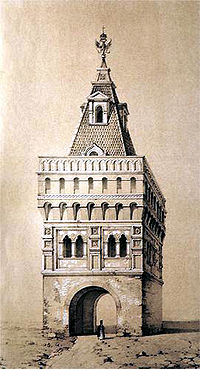
Armorial Gate
Encyclopedia

Russian architecture
Russian architecture follows a tradition whose roots were established in the Eastern Slavic state of Kievan Rus'. After the fall of Kiev, Russian architectural history continued in the principalities of Vladimir-Suzdal, Novgorod, the succeeding states of the Tsardom of Russia, the Russian Empire,...
. Situated in the Moscow Kremlin
Moscow Kremlin
The Moscow Kremlin , sometimes referred to as simply The Kremlin, is a historic fortified complex at the heart of Moscow, overlooking the Moskva River , Saint Basil's Cathedral and Red Square and the Alexander Garden...
, the structure was symbolic of the centralized Russian state. Its name references polychrome tiles of the second floor, which displayed heraldic emblems of formerly independent Russian principalities.
When constructing a palace for Ivan III in the late 15th century, the Italian architect Aloisio built an interior brick wall inside the Kremlin to defend the royal palace from south and west. The western wall was pierced by two arches, the smaller for pedestrians and the larger for vehicles. The larger gate was called Kolymazhnye, either from the old Russian word for vehicles or from the Kolymazhny Chamber situated nearby.
After the Romanov
Romanov
The House of Romanov was the second and last imperial dynasty to rule over Russia, reigning from 1613 until the February Revolution abolished the crown in 1917...
family ascended the throne in 1613, they rebuilt Ivan's residence into the Terem Palace
Terem Palace
Terem Palace or Teremnoy Palace is a historical building in the Moscow Kremlin, Russia, which used to be the main residence of the Russian tsars in the 17th century. Its name is derived from the Greek word τερεμνον...
. At about the same time, in the 1630s, they commissioned a tower to crown the Kolymazhnye Gate leading to the royal court.
The tower was square in plan, with the first floor pierced by a wide arch for vehicles. The second floor had twin double-arched windows with decorative elaborations of white stone. The third floor was pierced by a row of machicolation
Machicolation
A machicolation is a floor opening between the supporting corbels of a battlement, through which stones, or other objects, could be dropped on attackers at the base of a defensive wall. The design was developed in the Middle Ages when the Norman crusaders returned. A machicolated battlement...
s and a row of murder-hole
Murder-hole
A murder hole or meurtrière is a hole in the ceiling of a gateway or passageway in a fortification through which the defenders could fire, throw or pour harmful substances, such as rocks, arrows, scalding water, hot sand, quicklime, tar, or boiling oil, down on attackers. They also allowed water to...
s. Above that was a gallery ringed by a perforated parapet
Parapet
A parapet is a wall-like barrier at the edge of a roof, terrace, balcony or other structure. Where extending above a roof, it may simply be the portion of an exterior wall that continues above the line of the roof surface, or may be a continuation of a vertical feature beneath the roof such as a...
. The structure was crowned by a tiled tent, decorated with two levels of dormer
Dormer
A dormer is a structural element of a building that protrudes from the plane of a sloping roof surface. Dormers are used, either in original construction or as later additions, to create usable space in the roof of a building by adding headroom and usually also by enabling addition of windows.Often...
s and surmounted by a heraldic double-headed eagle
Double-headed eagle
The double-headed eagle is a common symbol in heraldry and vexillology. It is most commonly associated with the Byzantine Empire and the Holy Roman Empire. In Byzantine heraldry, the heads represent the dual sovereignty of the Emperor and/or dominance of the Byzantine Emperors over both East and...
.
By the 19th century, the wall had lost its defensive purpose and was dismantled. After that, the detached tower appeared redundant and was pulled down at the urging of the Kremlin's castellan in 1807.

